The Biomass of Pig-Blood-Derived Carbon as a Novel Electrode Material for Hydrogen Peroxide Electrochemical Sensing
Abstract
1. Instruction
2. Result and Discussion
3. Materials and Methods
3.1. Materials
3.2. Methods
4. Conclusions
Supplementary Materials
Author Contributions
Funding
Data Availability Statement
Conflicts of Interest
References
- Wang, Q.; Han, N.; Shen, Z.; Li, X.; Chen, Z.; Cao, Y.; Si, W.; Wang, F.; Ni, B.-J.; Thakur, V.K. MXene-based electrochemical (bio) sensors for sustainable applications: Roadmap for future advanced materials. Nano Mater. Sci. 2022; in press. [Google Scholar] [CrossRef]
- Zhang, R.; Chen, W.J.B. Recent advances in graphene-based nanomaterials for fabricating electrochemical hydrogen peroxide sensors. Bioelectronics 2017, 89, 249–268. [Google Scholar] [CrossRef] [PubMed]
- Li, M.; Wang, P.; Li, F.; Chu, Q.; Li, Y.; Dong, Y. An ultrasensitive sandwich-type electrochemical immunosensor based on the signal amplification strategy of mesoporous core-shell Pd@Pt nanoparticles/amino group functionalized graphene nanocomposite. Biosens. Bioelectron. 2017, 87, 752–759. [Google Scholar] [CrossRef] [PubMed]
- Xie, F.; Cao, X.; Qu, F.; Asiri, A.M.; Sun, X. Cobalt nitride nanowire array as an efficient electrochemical sensor for glucose and H2O2 detection. Sens. Actuators B Chem. 2018, 255, 1254–1261. [Google Scholar] [CrossRef]
- Cao, Y.; Qi, Y.; Meng, X.; Si, W.; Hao, Q.; Lei, W.; Li, J.; Cao, J.; Li, X.; Li, Q.; et al. Facile Preparation of Hemin/Polypyrrole/N, B-Co-Doped Graphene Nanocomposites for Non-Enzymatic H2O2 Determination. J. Electrochem. Soc. 2018, 165, B623. [Google Scholar] [CrossRef]
- Qi, X.; Yang, T.; Li, P.; Wei, Z. DFT study on ORR catalyzed by bimetallic Pt-skin metals over substrates of Ir, Pd and Au. Nano Mater. Sci. 2021; in press. [Google Scholar] [CrossRef]
- Cao, Y.; Si, W.; Hao, Q.; Li, Z.; Lei, W.; Xia, X.; Li, J.; Wang, F.; Liu, Y. One-pot fabrication of Hemin-NC composite with enhanced electrocatalysis and application to H2O2 sensing. Electrochim. Acta 2018, 261, 206–213. [Google Scholar] [CrossRef]
- Cao, Y.; Zhang, W.; Sun, Y.; Jiang, Y.; Han, N.; Zou, J.; Si, W.; Wang, F.; Núñez-Delgado, A.; Liu, S. Highly active iron-nitrogen-boron-carbon bifunctional electrocatalytic platform for hydrogen peroxide sensing and oxygen reduction. Environ. Res. 2021, 201, 111563. [Google Scholar] [CrossRef]
- Wang, J.; Zhao, C.-X.; Liu, J.-N.; Ren, D.; Li, B.-Q.; Huang, J.-Q.; Zhang, Q. Quantitative kinetic analysis on oxygen reduction reaction: A perspective. Nano Mater. Sci. 2021, 3, 313–318. [Google Scholar] [CrossRef]
- Sun, Y.; Zhang, W.; Wang, Q.; Han, N.; Núñez-Delgado, A.; Cao, Y.; Si, W.; Wang, F.; Liu, S. Biomass-derived N, S co-doped 3D multichannel carbon supported Au@ Pd@ Pt catalysts for oxygen reduction. Environ. Res. 2021, 202, 111684. [Google Scholar] [CrossRef]
- Gao, Z.; Zhang, Y.; Song, N.; Li, X. Biomass-derived renewable carbon materials for electrochemical energy storage. Mater. Res. Lett. 2017, 5, 69–88. [Google Scholar] [CrossRef]
- Duran-Jimenez, G.; Monti, T.; Titman, J.; Hernandez-Montoya, V.; Kingman, S.; Binner, E. New insights into microwave pyrolysis of biomass: Preparation of carbon-based products from pecan nutshells and their application in wastewater treatment. J. Anal. Appl. Pyrolysis 2017, 124, 113–121. [Google Scholar] [CrossRef]
- Zhao, L.; Jiang, J.; Xiao, S.; Li, Z.; Wang, J.; Wei, X.; Kong, Q.; Chen, J.S.; Wu, R. PtZn nanoparticles supported on porous nitrogen-doped carbon nanofibers as highly stable electrocatalysts for oxygen reduction reaction. Nano Mater. Sci. 2022; in press. [Google Scholar] [CrossRef]
- Qin, D.; Chen, S. A sustainable synthesis of biomass carbon sheets as excellent performance sodium ion batteries anode. J. Solid State Electrochem. 2017, 21, 1305–1312. [Google Scholar] [CrossRef]
- Tian, N.; Qin, A.M.; Liao, L.; Zhang, K.Y.; Wang, M.P. Synthesis of MoSe2-MoO2@ Biomass-Derived Honeycombed Carbon Composite and Its Application in LIB. In Key Engineering Materials; Trans Tech Publications, Ltd.: Bäch, Switzerland, 2017; Volume 727, pp. 645–652. [Google Scholar] [CrossRef]
- Liu, M.; Yin, X.; Guo, X.; Hu, L.; Yuan, H.; Wang, G.; Wang, F.; Chen, L.; Zhang, L.; Yu, F. High efficient oxygen reduction performance of Fe/Fe3C nanoparticles in situ encapsulated in nitrogen-doped carbon via a novel microwave-assisted carbon bath method. Nano Mater. Sci. 2019, 1, 131–136. [Google Scholar] [CrossRef]
- Gong, Y.; Li, D.; Luo, C.; Fu, Q.; Pan, C. Highly porous graphitic biomass carbon as advanced electrode materials for supercapacitors. Green Chem. 2017, 19, 4132–4140. [Google Scholar] [CrossRef]
- Deng, L.; Zhong, W.; Wang, J.; Zhang, P.; Fang, H.; Yao, L.; Liu, X.; Ren, X.; Li, Y. The enhancement of electrochemical capacitance of biomass-carbon by pyrolysis of extracted nanofibers. Electrochim. Acta 2017, 228, 398–406. [Google Scholar] [CrossRef]
- Ouyang, J. Applications of carbon nanotubes and graphene for third-generation solar cells and fuel cells. Nano Mater. Sci. 2019, 1, 77–90. [Google Scholar] [CrossRef]
- Wang, H.; Fu, F.; Huang, M.; Feng, Y.; Han, D.; Xi, Y.; Xiong, W.; Yang, D.; Niu, L. Lignin-based materials for electrochemical energy storage devices. Nano Mater. Sci. 2022; in press. [Google Scholar] [CrossRef]
- Pistone, A.; Espro, C. Current trends on turning biomass wastes into carbon materials for electrochemical sensing and rechargeable battery applications. Curr. Opin. Green Sustain. Chem. 2020, 26, 100374. [Google Scholar] [CrossRef]
- Yu, Z.; Liu, C.; Chen, J.; Yuan, Z.; Chen, Y.; Wei, L. High-performance Fe–N–C electrocatalysts with a “chain mail” protective shield. Nano Mater. Sci. 2021, 3, 420–428. [Google Scholar] [CrossRef]
- Mao, S.; Wang, Z.; Chen, Z.; Wu, K.; Zhang, K.; Li, Q.; Yan, H.; Lü, G.; Huang, G.; Wang, Y. Towards the selectivity distinction of phenol hydrogenation on noble metal catalysts. Nano Mater. Sci. 2020; in press. [Google Scholar] [CrossRef]
- Bhat, V.S.; Supriya, S.; Hegde, G. Biomass derived carbon materials for electrochemical sensors. J. Electrochem. Soc. 2019, 167, 037526. [Google Scholar] [CrossRef]
- Li, C.; Luo, M.; Xia, Z.; Guo, S. High-index faceted noble metal nanostructures drive renewable energy electrocatalysis. Nano Mater. Sci. 2020, 2, 309–315. [Google Scholar] [CrossRef]
- Zhang, Z.; Chen, K.; Zhao, Q.; Huang, M.; Ouyang, X. Electrocatalytic and photocatalytic performance of noble metal doped monolayer MoS2 in the hydrogen evolution reaction: A first principles study. Nano Mater. Sci. 2021, 3, 89–94. [Google Scholar] [CrossRef]
- Chen, M.; Jiang, S.; Huang, C.; Wang, X.; Cai, S.; Xiang, K.; Zhang, Y.; Xue, J. Honeycomb-like Nitrogen and Sulfur Dual-Doped Hierarchical Porous Biomass-Derived Carbon for Lithium–Sulfur Batteries. ChemSusChem 2017, 10, 1803–1812. [Google Scholar] [CrossRef]
- Yang, H.; Tang, Y.; Sun, X.; Liu, Q.; Huang, X.; Wang, L.; Fu, Z.; Zhang, Q.; Or, S.W. Biomass-derived porous carbon materials with NiS nanoparticles for high performance supercapacitors. J. Mater. Sci. Mater. Electron. 2017, 28, 14874–14883. [Google Scholar] [CrossRef]
- Gao, S.; Li, X.; Li, L.; Wei, X. A versatile biomass derived carbon material for oxygen reduction reaction, supercapacitors and oil/water separation. Nano Energy 2017, 33, 334–342. [Google Scholar] [CrossRef]
- Yang, W.; Xu, S.; Ma, K.; Wu, C.; Gates, I.D.; Ding, X.; Meng, W.; Gao, Z. Geometric structures, electronic characteristics, stabilities, catalytic activities, and descriptors of graphene-based single-atom catalysts. Nano Mater. Sci. 2020, 2, 120–131. [Google Scholar] [CrossRef]
- De Clercq, R.; Dusselier, M.; Sels, B.F. Heterogeneous catalysis for bio-based polyester monomers from cellulosic biomass: Advances, challenges and prospects. Green Chem. 2017, 19, 5012–5040. [Google Scholar] [CrossRef]
- Zhao, X.; Pang, J.; Li, G.; Liu, F.; Xu, J.; Zheng, M.; Li, N.; Li, C.; Wang, A.; Zhang, T. Activated Carbon and Ordered Mesoporous Carbon-Based Catalysts for Biomass Conversion. In Nanoporous Catalysts for Biomass Conversion; Wiley and Sons: Hoboken, NJ, USA, 2017; pp. 17–54. [Google Scholar] [CrossRef]
- Jia, Z.; Li, Z.; Ni, T.; Li, S. Adsorption of low-cost absorption materials based on biomass (Cortaderia selloana flower spikes) for dye removal: Kinetics, isotherms and thermodynamic studies. J. Mol. Liq. 2017, 229, 285–292. [Google Scholar] [CrossRef]
- Han, N.; Zhao, X.; Thakur, V.K. Adjusting the interfacial adhesion via surface modification to prepare high-performance fibers. Nano Mater. Sci. 2021, in press. [Google Scholar] [CrossRef]
- Veeramani, V.; Sivakumar, M.; Chen, S.-M.; Madhu, R.; Alamri, H.R.; Alothman, Z.A.; Hossain, S.A.; Chen, C.-K.; Yamauchi, Y.; Miyamoto, N.; et al. Lignocellulosic biomass-derived, graphene sheet-like porous activated carbon for electrochemical supercapacitor and catechin sensing. RSC Adv. 2017, 7, 45668–45675. [Google Scholar] [CrossRef]
- Wu, Z.; Yang, W.; Chen, L.; Meng, H.; Zhao, J.; Wang, S. Morphology and microstructure of co-pyrolysis char from bituminous coal blended with lignocellulosic biomass: Effects of cellulose, hemicellulose and lignin. Appl. Therm. Eng. 2017, 116, 24–32. [Google Scholar] [CrossRef]
- Chulliyote, R.; Hareendrakrishnakumar, H.; Raja, M.; Gladis, J.M.; Stephan, A.M. Sulfur-Immobilized Nitrogen and Oxygen Co–Doped Hierarchically Porous Biomass Carbon for Lithium-Sulfur Batteries: Influence of Sulfur Content and Distribution on Its Performance. ChemistrySelect 2017, 2, 10484–10495. [Google Scholar] [CrossRef]
- Watanabe, M.; Uchida, M.; Motoo, S. Preparation of highly dispersed Pt+ Ru alloy clusters and the activity for the electrooxidation of methanol. J. Electroanal. Chem. Interfacial Electrochem. 1987, 229, 395–406. [Google Scholar] [CrossRef]
- Si, W.; Han, Z.; Lei, W.; Wu, Q.; Zhang, Y.; Xia, M.; Hao, Q. Fast electrochemical determination of imidacloprid at an activated glassy carbon electrode. J. Electrochem. Soc. 2013, 161, B9. [Google Scholar] [CrossRef]
- Quezada, V.; Martinez, T.; Nelson, R.; Pérez-Fehrmann, M.; Zaragoza, G.; Vizcarra, A.; Kesternich, V.; Hernández-Saravia, L.P. A novel platform of using copper (II) complex with triazole-carboxilated modified as bidentated ligand SPCE for the detection of hydrogen peroxide in milk. J. Electroanal. Chem. 2020, 879, 114763. [Google Scholar] [CrossRef]
- Dantas, L.M.F.; Castro, P.S.; Peña, R.C.; Bertotti, M. Amperometric determination of hydrogen peroxide using a copper microelectrode. Anal. Methods 2014, 6, 2112–2116. [Google Scholar] [CrossRef]
- Sukeri, A.; Lima, A.S.; Bertotti, M. Development of non-enzymatic and highly selective hydrogen peroxide sensor based on nanoporous gold prepared by a simple unusual electrochemical approach. Microchem. J. 2017, 133, 149–154. [Google Scholar] [CrossRef]
- Sukeri, A.; Bertotti, M. Electrodeposited honeycomb-like dendritic porous gold surface: An efficient platform for enzyme-free hydrogen peroxide sensor at low overpotential. J. Electroanal. Chem. 2017, 805, 18–23. [Google Scholar] [CrossRef]
- Arjunan, A.; Sukeri, A.; Saraiva, D.P.M.; Miranda, P.B.; Bertotti, M. Electrochemical studies of hydrogen peroxide oxidation on a nanoporous gold surface: Fundamental and analytical applications. J. Electrochem. Soc. 2020, 167, 116507. [Google Scholar] [CrossRef]

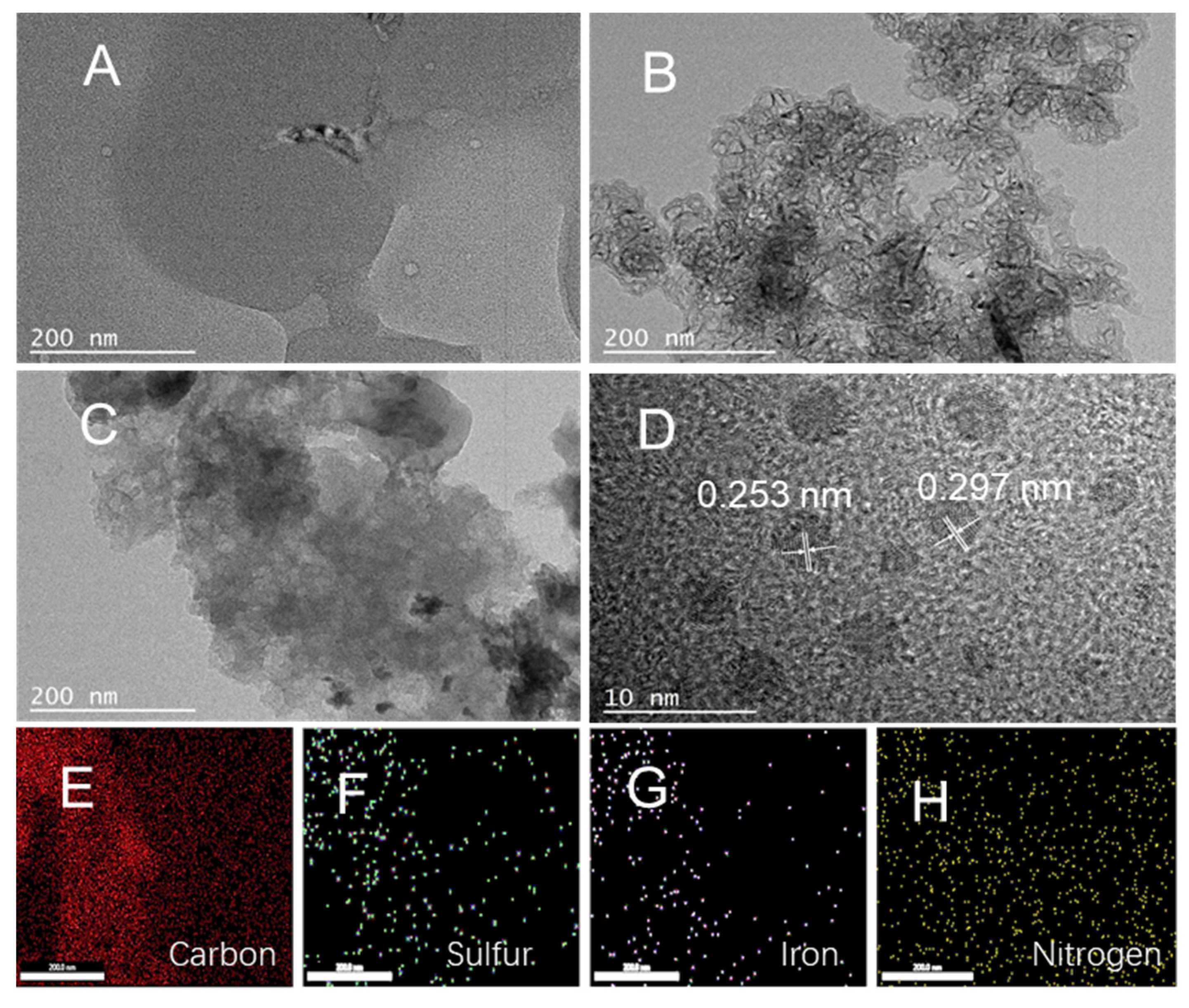
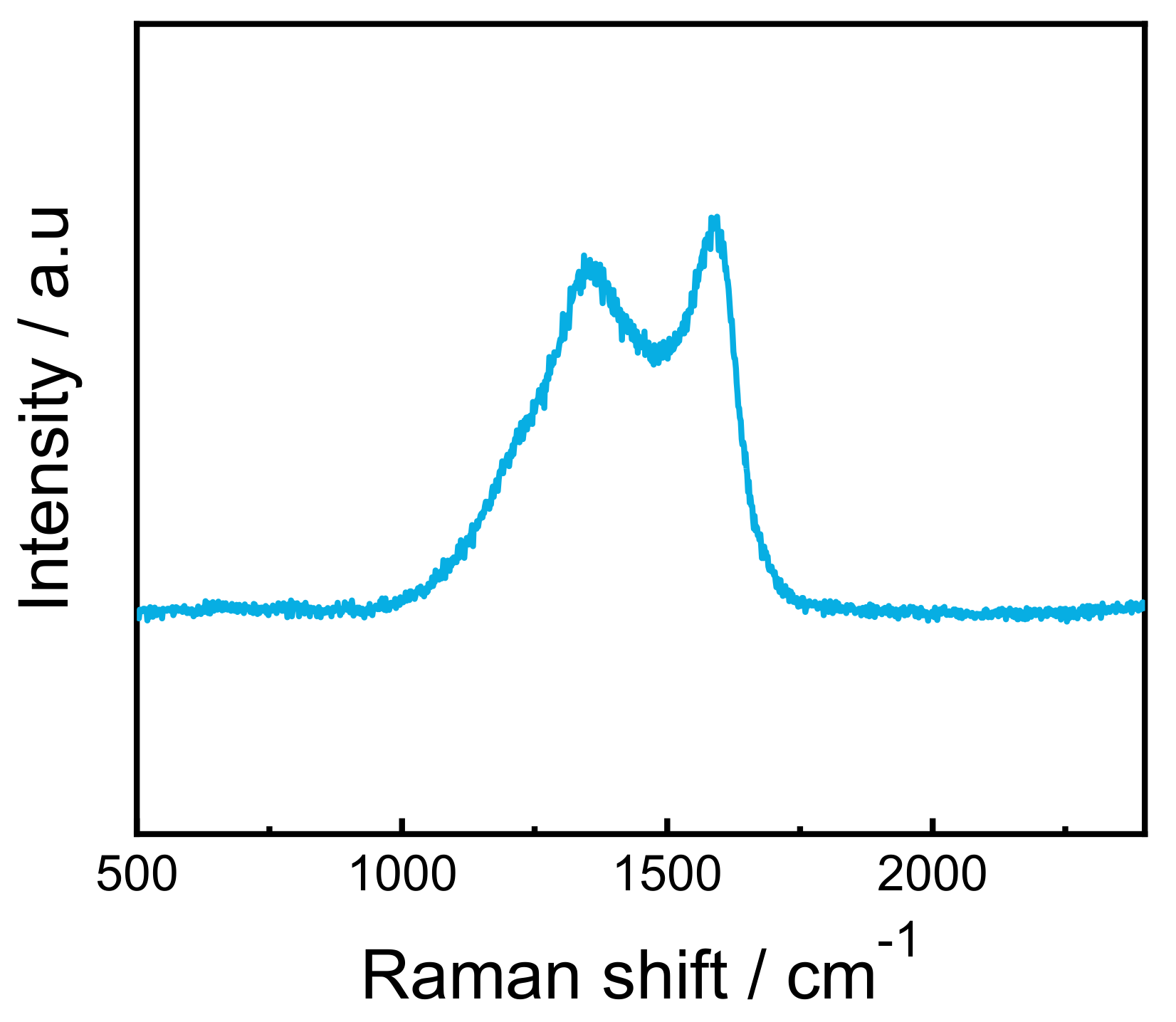
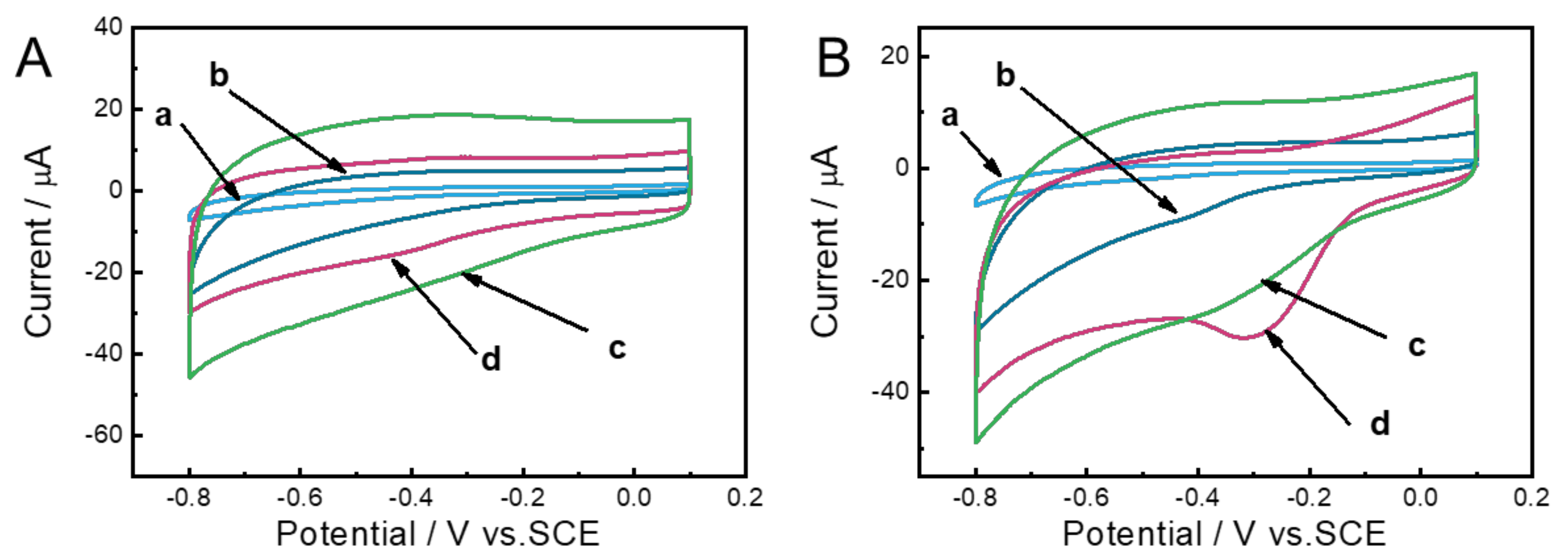
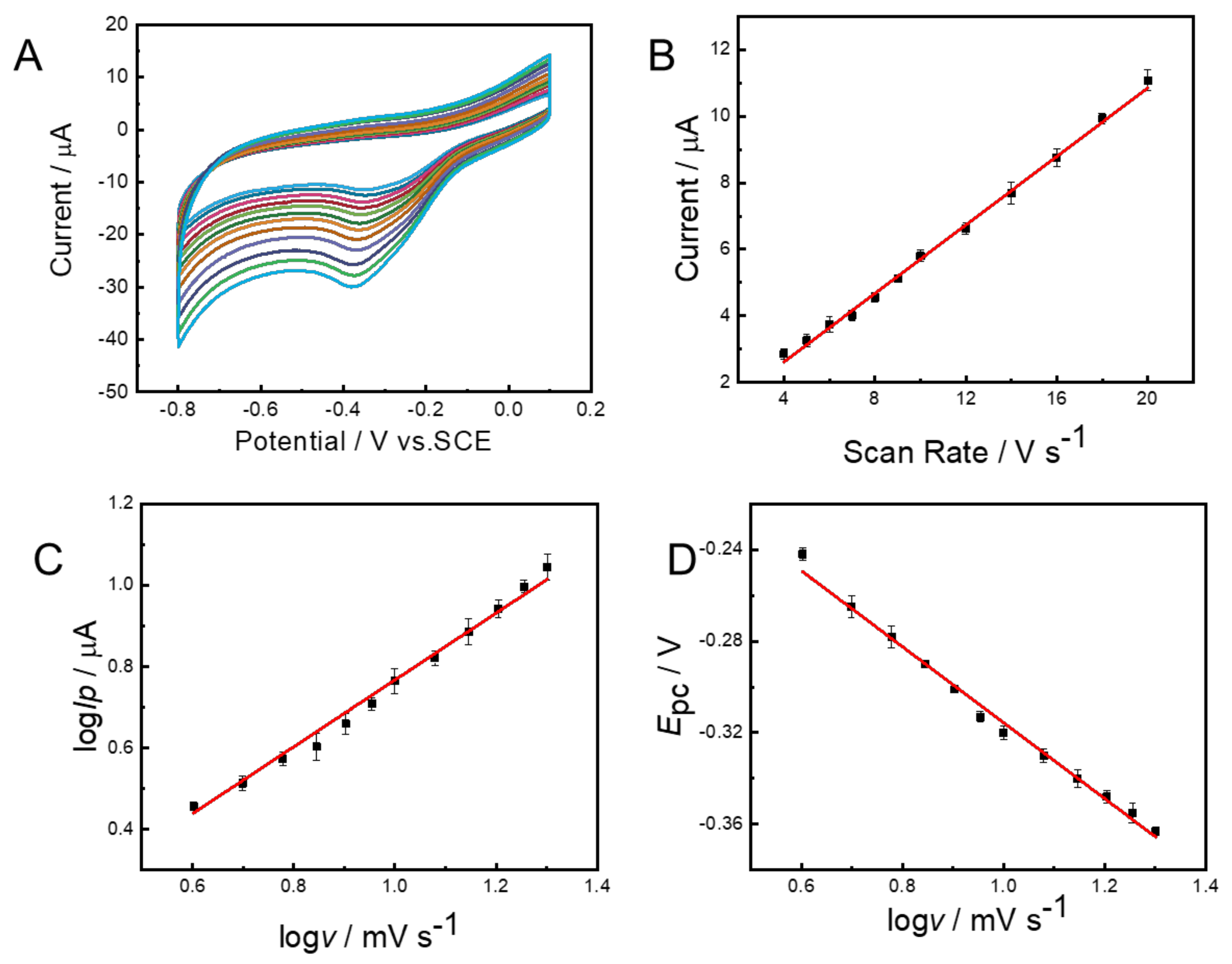
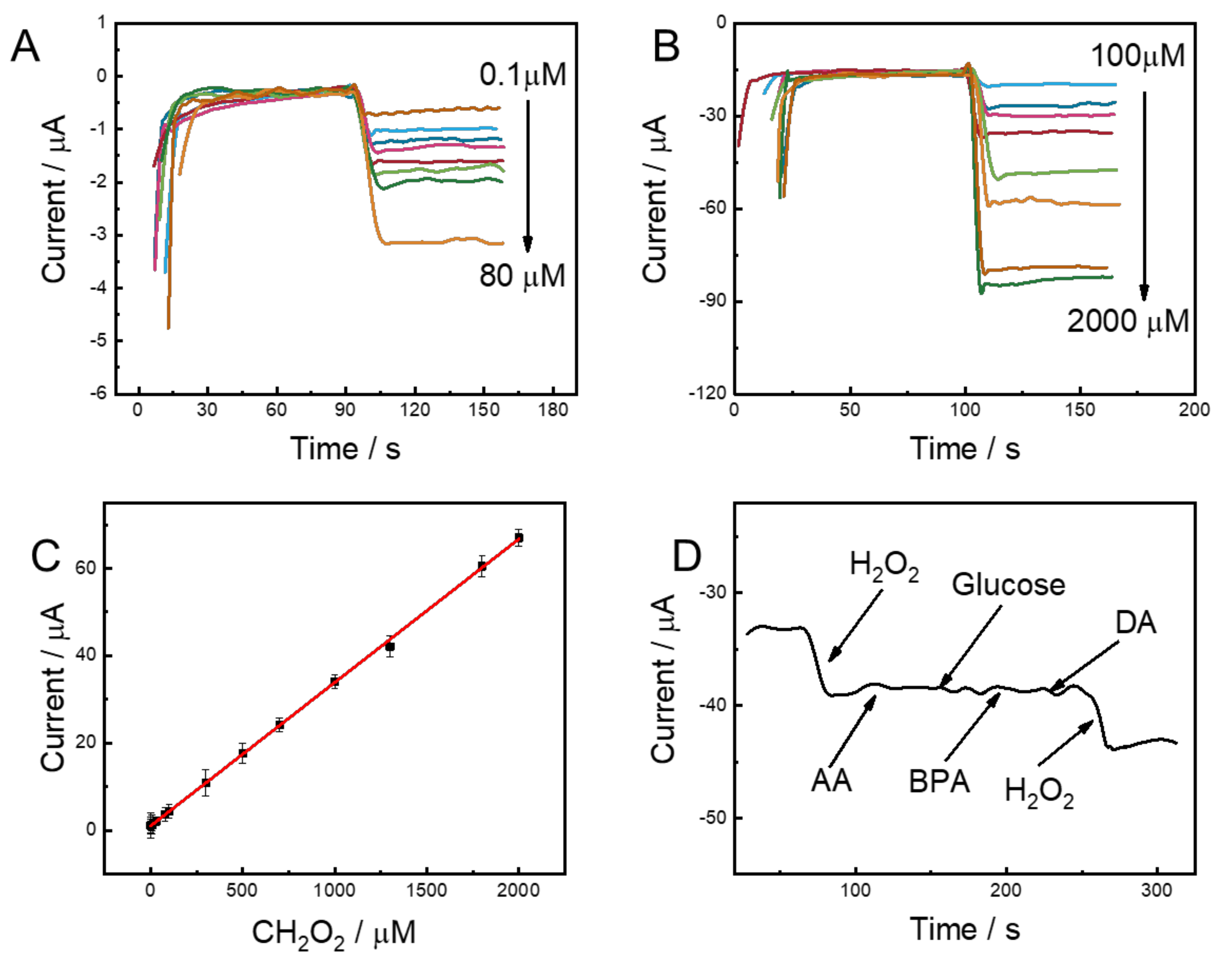
| Signal Amplification Strategy | Assay Principle | Linear Range μM | Limit of Detection μM | Reference |
|---|---|---|---|---|
| a Cu(bmtc)2(H2O)]/SPCE | i-t | 10–524 | 0.57 | [40] |
| Cu microelectrode | i-t | 15–1820 | 2.7 | [41] |
| Nanoporous gold film electrode | i-t | 1–1000 | 3.7 | [42] |
| Porous Au film electrode | i-t | 30–360 | 3 | [43] |
| Nanoporous gold | i-t | 10–1800 | 0.6 | [44] |
| Fe-BC | i-t | 0.1–2000 | 0.046 | This work |
Publisher’s Note: MDPI stays neutral with regard to jurisdictional claims in published maps and institutional affiliations. |
© 2022 by the authors. Licensee MDPI, Basel, Switzerland. This article is an open access article distributed under the terms and conditions of the Creative Commons Attribution (CC BY) license (https://creativecommons.org/licenses/by/4.0/).
Share and Cite
Liu, G.; Li, X.; Wang, Q.; Sun, K.; Lee, C.; Cao, Y.; Si, W.; Wei, H.; Li, Z.; Wang, F. The Biomass of Pig-Blood-Derived Carbon as a Novel Electrode Material for Hydrogen Peroxide Electrochemical Sensing. Catalysts 2022, 12, 1438. https://doi.org/10.3390/catal12111438
Liu G, Li X, Wang Q, Sun K, Lee C, Cao Y, Si W, Wei H, Li Z, Wang F. The Biomass of Pig-Blood-Derived Carbon as a Novel Electrode Material for Hydrogen Peroxide Electrochemical Sensing. Catalysts. 2022; 12(11):1438. https://doi.org/10.3390/catal12111438
Chicago/Turabian StyleLiu, Guolei, Xue Li, Qing Wang, Kuizhao Sun, Chuping Lee, Yue Cao, Weimeng Si, Haoran Wei, Zhongfang Li, and Fagang Wang. 2022. "The Biomass of Pig-Blood-Derived Carbon as a Novel Electrode Material for Hydrogen Peroxide Electrochemical Sensing" Catalysts 12, no. 11: 1438. https://doi.org/10.3390/catal12111438
APA StyleLiu, G., Li, X., Wang, Q., Sun, K., Lee, C., Cao, Y., Si, W., Wei, H., Li, Z., & Wang, F. (2022). The Biomass of Pig-Blood-Derived Carbon as a Novel Electrode Material for Hydrogen Peroxide Electrochemical Sensing. Catalysts, 12(11), 1438. https://doi.org/10.3390/catal12111438











